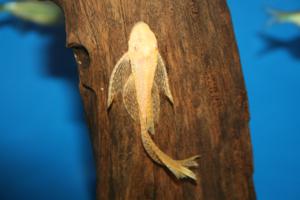
Albino Longfin Bristlenose Pleco (Ancistrus dolichopterus)
Overview: The Bristlenose is a hard working pleco that is always looking for algae to eat. Adult Bristlenoses will grow distishing bristle on the top of their noses, males will grow larger bristles than the females. Unlike the Common pleco the Bristlenose will stay smaller.
Native Range: 72 - 84 ºF
Max. Length: 6 inches
Water: 72 - 84 ºF, pH: 5.5 - 8.0
Feeding: Algae-Eater
Behavior & Care: They are peaceful fish in general. Older males may show some aggression towards other Plecos but this should not be a problem providing that there is enough space and hiding place for everyone. They are ideal for a community fish tank and some adults can be in some cichlid aquariums.They love driftwood to chew on and fast moving water. |
%202_260x225.jpg)
Longfin Bristlenose Pleco (Ancistrus dolichopterus)
Overview: The Bristlenose is a hard working pleco that is always looking for algae to eat. Adult Bristlenoses will grow distishing bristle on the top of their noses, males will grow larger bristles than the females. Unlike the Common pleco the Bristlenose will stay smaller.
Native Range: 72 - 84 ºF
Max. Length: 6 inches
Water: 72 - 84 ºF, pH: 5.5 - 8.0
Feeding: Algae-Eater
Behavior & Care: They are peaceful fish in general. Older males may show some aggression towards other Plecos but this should not be a problem providing that there is enough space and hiding place for everyone. They are ideal for a community fish tank and some adults can be in some cichlid aquariums.They love driftwood to chew on and fast moving water. |
|
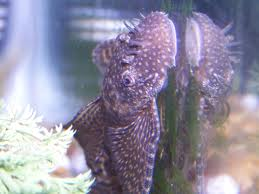
Bristlenose Pleco (Ancistrus sp.)
Overview: These plecos are algae eating machines, but rarely eat aquarium plants. Gentle enough to be with community fish and Discus, but when larger can handle being with some cichlids.
Native range: South America
Size: 5-6 inches
Water: 69-80°F, pH 6.2 - 7.2
Feeding: Vegetables, algae wafers, drift wood and once a week frozen or live foods.
Care & Breeding: Give plenty caves and places to hide and feel secure. Mature males and sometimes females have soft tentacles (bushy fleshy growths) on the snout. Adult males can be territorial towards other males.
|
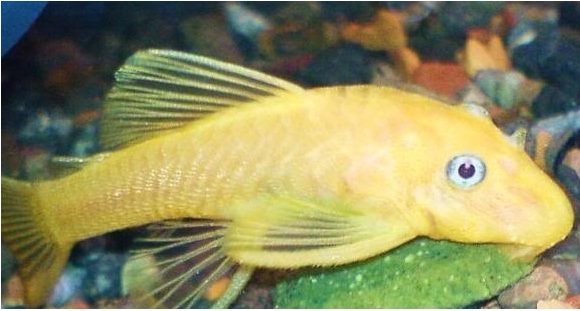
Blue Eye Bristlenose Pleco (Ancistrus sp. L144)
Overview: These plecos are actually Leustic, not albino. They are algae eating machines, but rarely eat aquarium plants. Gentle enough to be with community fish and Discus, but when larger can handle being with some cichlids.
Native range: South America
Size: 4-5 inches
Water: 69-80°F, pH 6.2 - 7.2
Feeding: Vegetables, algae wafers, drift wood and once a week frozen or live foods.
Care & Breeding: Give plenty caves and places to hide and feel secure. Mature males and sometimes females have soft tentacles (bushy fleshy growths) on the snout. Adult males can be territorial towards other males.
|
|
|
| |
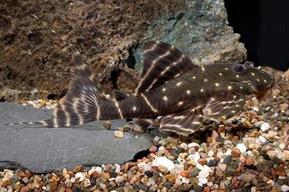
Emperor Pleco (Panaque sp. L204)
Overview: This fish is a native of Peru, and is one of the more highly sought after Plecostomus in the mid-level price range. This Plecostomus will usually only be active during feeding and at night.
Native Range: South America
Max. Length: 5 inches
Water: 72 - 80 F pH: 6.5 - 7.5
Feeding: Omnivore
Behavior & Care: While their primary diet is algae, they will scavenge other foods and should have their diet supplemented with algae wafers and blanched zucchini spears. The scales of the pleco act as armor plating and allow the pleco to survive with much larger fish. Most plecos will tolerate other plecos in the same aquarium, but there are exceptions, and plenty of hiding places are required. Generally long lived, the pleco can make a great addition as a scavenger in the aquarium. |
|
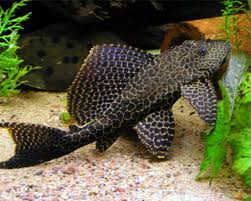 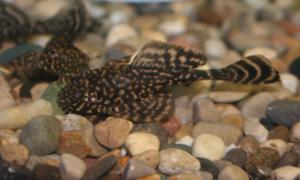
Sailfin Pleco (Glyptoperichthys gibbiceps L083)
Overview: The Sailfin Pleco comes from the rivers and tributaries of South America. The body is different shades of brown with a pattern of lighter markings covering it. This species receives its name from its large dorsal fin.
Native Range: Peru & Brazil
Max. Length: 1ft +
Water: 74-79° F, pH: 6.5-7.4
Feeding: Omnivore-Algae Eater
Behavior & Care: Sailfin Plecos make good additions to any community aquarium. Planted aquariums with hearty, fast-growing plants, high aeration, and water movement make for a healthy environment. |
|
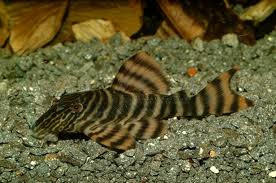
Tiger Pleco (Peckoltia vermiculata L002)
Overview: The Tiger Pleco comes from the Amazon Basin of South America. It gets its name from the striped pattern it has on its body. Constant temperature and pH levels will help maintain this peaceful Plecostomus' health. Tiger Plecos make good additions to any community aquarium.
Native Range: South America
Max. Length: 5 inches
Water: 72-76° F, KH 8-12, pH 6.5-7.5
Feeding: Omnivore
Behavior & Care: Planted aquariums with high aeration and water movement make for a healthy environment. Rocks and driftwood help to accent a natural habitat and provide hiding spaces to reduce stress for the Tiger Pleco. A 30 gallon aquarium or larger is recommended for this species. |
|
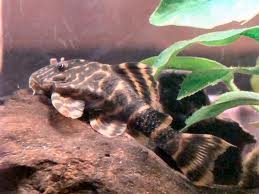
Striped Clown Pleco (Panaque maccus L104)
Overview: The Clown Pleco is a beautiful specimen exhibiting a brown and tan stripe pattern (which changes as the fish matures). If you need to see your fish on a daily, weekly, or even monthly basis this fish probably is not for you. The Clown Pleco is found in root structures at the banks and driftwood dams. Where, due to its coloration, it is difficult to find. Properly housed, the same conditions in your tank will make him difficult to spot.
Native Range: Colombia and Venezuela
Max. Length: 4 inches
Water: 73-82 F pH: 6.8-7.6
Feeding: Herbivore
Behavior & Care: The Clown pleco should never be kept in an aquarium without wood since it is a wood eating species. Ideally include several types of wood in the set up The Clown pleco does eat algae but it is not the most efficient algae eating pleco on the market. |
|
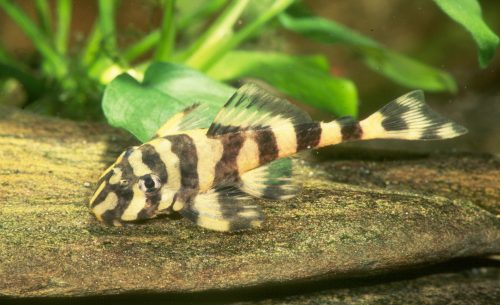
Butterfly Pleco (Dekeyseria brachyura L052) |
Overview: The Butterfly Pleco has a dark black body with wide white/golden bands on the body and fins. The first ray of the pectoral fins have small bristles and the tail is angled, sloping from the top to a wider bottom.
Native Region: South America
Size: 5 to 7 inches
Water: 75.2 - 82.4 °F pH 5.5 - 7.2
Temperament: Peaceful
Diet: Omnivore
Care: The aquarium should have lot of hiding spots. Flat rocks work for making caves and a place for the pleco to stick to. Driftwood is an important part of the pleco's diet. The Butterfly pleco can change colors to stay camouflage, therefore the aquarium and décor can affect the appearance of the pleco.
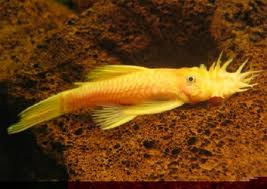
Black Eyed Bristlenose (Ancistrus sp. (4) L144)
Overview: These plecos are actually Leustic, not albino. They are algae eating machines, but rarely eat aquarium plants. Gentle enough to be with community fish and Discus, but when larger can handle being with some cichlids.
Native range: South America
Size: 4-5 inches
Water: 69-80°F, pH 6.2 - 7.2
Feeding: Vegetables, algae wafers, drift wood and once a week frozen or live foods.
Care & Breeding: Give plenty caves and places to hide and feel secure. Mature males and sometimes females have soft tentacles (bushy fleshy growths) on the snout. Adult males can be territorial towards other males.
|
| 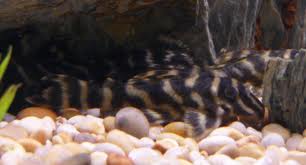
Chocolate Zebra Pleco (Hypancistrus sp. L270)
Overview: Unlike their Zebra pleco cousins, these plecos have large bands of yellow-gold in between darker bands. Chocolate Zebra plecos are very peaceful, but can be very shy in a new tank.
Native range: South America
Size: 4-5 inches
Water: 77°F - 86°F, pH 6-8
Feeding: Carnivore; Prefers meaty foods, though vegetable matter should be incorporated into its diet.
Care & Breeding: Give plenty caves and places to hide and feel secure. Odontodes are more evident in males. Given appropriately sized caves, hearty feedings, pristine water quality, and medium-high water flow, spawns will likely occur.
|
|
|

%202_260x225.jpg)











